Jwst
- All
- News
- Videos
- Web Stories
-

Webb Finds Phosphorus-Bearing Gas in an Ancient Brown Dwarf
- Monday November 10, 2025
- Written by Gadgets 360 Staff
NASA’s James Webb Space Telescope has detected phosphine (PH₃) in the atmosphere of the ancient brown dwarf Wolf 1130C, about 54 light-years away in Cygnus. This marks the first confirmed detection of a phosphorus-bearing gas in such a metal-poor object. The finding surprises astronomers, as phosphine was previously undetected in similar brown ...
-
 www.gadgets360.com
www.gadgets360.com
-

NASA's James Webb Space Telescope Telescope Challenges Old Theories on Mini-Neptune Worlds
- Friday November 7, 2025
- Written by Gadgets 360 Staff
New models suggest mini-Neptunes—planets smaller than Neptune with thick gas envelopes—may have solid rocky surfaces instead of molten magma. Data from NASA’s JWST revealed high-pressure atmospheres capable of compressing molten rock into solid crusts. This discovery challenges earlier assumptions and offers key insights into exoplanet compos...
-
 www.gadgets360.com
www.gadgets360.com
-

NASA’s JWST Produces First-Ever 3D Map of Distant Planet WASP-18b
- Monday November 3, 2025
- Written by Gadgets 360 Staff
NASA’s James Webb Space Telescope has created the first-ever 3D atmospheric map of an exoplanet, revealing the extreme conditions on WASP-18b, an “ultra-hot Jupiter” located 400 light-years away. Using infrared eclipse mapping, scientists discovered a scorching hotspot over 2,700 °C where water molecules are breaking apart. This groundbreaki...
-
 www.gadgets360.com
www.gadgets360.com
-

James Webb Telescope Finds Early Universe Galaxies Were More Chaotic Than We Thought
- Thursday October 23, 2025
- Written by Gadgets 360 Staff
The James Webb Space Telescope has revealed that galaxies in the early universe were far more chaotic and unstable than once believed. A new study shows that gas turbulence and intense star formation disrupted young galaxies, reshaping scientists’ understanding of how galaxies evolved into the structured systems seen today.
-
 www.gadgets360.com
www.gadgets360.com
-

James Webb Telescope Uncovers the Turbulent Birth of the First Galaxies
- Saturday October 25, 2025
- Written by Gadgets 360 Staff
Using JWST data, astronomers analyzed more than 250 galaxies from the universe’s first 1.5 billion years and found most were chaotic, with gas swirling in all directions. Only a few showed early signs of ordered rotation. The findings reveal how intense star formation and gravitational turbulence gave way to stability, transforming the early univ...
-
 www.gadgets360.com
www.gadgets360.com
-

James Webb Telescope Spots Evidence of a Black Hole Carving a Massive Scar Through a Galaxy
- Thursday October 9, 2025
- Written by Gadgets 360 Staff
Astronomers using JWST and ALMA discovered a 20,000-light-year-long contrail in galaxy NGC 3627. Scientists believe it was carved by a massive black hole traveling through the galactic disk, leaving behind a turbulent scar of dust and gas that may offer new clues to galaxy evolution.
-
 www.gadgets360.com
www.gadgets360.com
-

James Webb Space Telescope Detects Phosphine on Brown Dwarf Wolf 1130C
- Thursday October 9, 2025
- Written by Gadgets 360 Staff
Using the James Webb Space Telescope, scientists have detected phosphine gas in the atmosphere of the brown dwarf Wolf 1130C, about 54 light-years away. The finding suggests phosphine can form in extreme, non-biological environments, challenging its status as a potential biomarker and reshaping how scientists search for alien life.
-
 www.gadgets360.com
www.gadgets360.com
-

JWST Reveals Stunning New Details About M87’s Supermassive Black Hole Jet
- Saturday October 4, 2025
- Written by Gadgets 360 Staff
Recent images captured by the James Webb Space Telescope (JWST) are the clearest ever pictures of the jet arriving from the massive black hole in the galaxy named Messier 87 (M87). There are clear details in the image shot by the telescope, which show the change of brightness, shape and the jet that is usually in disguise. As per scientists, this d...
-
 www.gadgets360.com
www.gadgets360.com
-

JWST Delivers First-Ever Weather Report of Rogue Brown Dwarf World Glowing With Auroras
- Wednesday October 1, 2025
- Written by Gadgets 360 Staff
Astronomers using JWST have delivered the first weather report of SIMP-0136, a rogue brown dwarf about 20 light-years away. The study revealed stable silicate clouds, auroras heating the upper atmosphere, and possible giant storm systems. Findings mark a breakthrough in studying alien weather and pave the way for mapping exoplanet climates.
-
 www.gadgets360.com
www.gadgets360.com
-

James Webb Telescope Unveils Hidden Star-Forming Regions in Sagittarius B2
- Wednesday October 1, 2025
- Written by Gadgets 360 Staff
New JWST observations reveal the hidden star-forming activity inside Sagittarius B2, the Milky Way’s largest molecular cloud. By seeing through dense dust, astronomers can study how stars form efficiently in extreme environments. These findings help explain not only Sgr B2 but also broader mechanisms shaping galaxies.
-
 www.gadgets360.com
www.gadgets360.com
-

NASA’s James Webb Telescope May Have Found First Black Hole Star, Known as ‘The Cliff’
- Thursday September 25, 2025
- Written by Gadgets 360 Staff
JWST detected “The Cliff,” a candidate black hole star with a black hole core wrapped in a luminous gas shell. This discovery offers insights into black hole formation, stellar evolution, and cosmic dynamics, prompting astronomers to search for similar objects across the universe.
-
 www.gadgets360.com
www.gadgets360.com
-

Not Like Venus Or Mars, Distant Exoplanet May Have Atmosphere Like Earth's
- Friday September 19, 2025
- World News | Edited by NDTV News Desk
A distant exoplanet might have an atmosphere similar to Earth's, early observations from the James Webb Space Telescope (JWST) suggest. It is part of a group of planets orbiting a star called TRAPPIST-1, about 40 light-years away from Earth.
-
 www.ndtv.com
www.ndtv.com
-

NASA Confirms Discovery of 6,000 Exoplanets Beyond Our Solar System
- Sunday September 21, 2025
- Written by Gadgets 360 Staff
NASA has confirmed 6,000 exoplanets beyond our solar system, highlighting three decades of accelerating discovery. From scorching hot Jupiters to worlds with jewel-like clouds, the catalog reflects cosmic diversity. Future missions aim to identify true Earth analogs and investigate signs of life across distant planetary systems.
-
 www.gadgets360.com
www.gadgets360.com
-

JWST Identifies Compact, Metal-Poor Star-Forming Region Tracing Back to Early Universe
- Wednesday September 17, 2025
- Written by Gadgets 360 Staff
Astronomers using JWST have discovered LAP2, a tiny star-forming complex magnified by Abell 2744. With extremely low metallicity and a size under 33 light years, it provides rare insight into conditions resembling the early universe, offering clues about how the first stars formed and enriched galaxies with heavier elements
-
 www.gadgets360.com
www.gadgets360.com
-

Tiny Red Dots Spotted By NASA’s James Webb Telescope Could Be Black Hole Stars
- Thursday September 25, 2025
- Written by Gadgets 360 Staff
NASA’s James Webb Space Telescope revealed mysterious “little red dots” that seem too bright and mature for their age. A new study suggests they may be black hole stars—giant hydrogen spheres powered by black holes—helping explain the rapid growth of early supermassive black holes.
-
 www.gadgets360.com
www.gadgets360.com
-

Webb Finds Phosphorus-Bearing Gas in an Ancient Brown Dwarf
- Monday November 10, 2025
- Written by Gadgets 360 Staff
NASA’s James Webb Space Telescope has detected phosphine (PH₃) in the atmosphere of the ancient brown dwarf Wolf 1130C, about 54 light-years away in Cygnus. This marks the first confirmed detection of a phosphorus-bearing gas in such a metal-poor object. The finding surprises astronomers, as phosphine was previously undetected in similar brown ...
-
 www.gadgets360.com
www.gadgets360.com
-

NASA's James Webb Space Telescope Telescope Challenges Old Theories on Mini-Neptune Worlds
- Friday November 7, 2025
- Written by Gadgets 360 Staff
New models suggest mini-Neptunes—planets smaller than Neptune with thick gas envelopes—may have solid rocky surfaces instead of molten magma. Data from NASA’s JWST revealed high-pressure atmospheres capable of compressing molten rock into solid crusts. This discovery challenges earlier assumptions and offers key insights into exoplanet compos...
-
 www.gadgets360.com
www.gadgets360.com
-

NASA’s JWST Produces First-Ever 3D Map of Distant Planet WASP-18b
- Monday November 3, 2025
- Written by Gadgets 360 Staff
NASA’s James Webb Space Telescope has created the first-ever 3D atmospheric map of an exoplanet, revealing the extreme conditions on WASP-18b, an “ultra-hot Jupiter” located 400 light-years away. Using infrared eclipse mapping, scientists discovered a scorching hotspot over 2,700 °C where water molecules are breaking apart. This groundbreaki...
-
 www.gadgets360.com
www.gadgets360.com
-

James Webb Telescope Finds Early Universe Galaxies Were More Chaotic Than We Thought
- Thursday October 23, 2025
- Written by Gadgets 360 Staff
The James Webb Space Telescope has revealed that galaxies in the early universe were far more chaotic and unstable than once believed. A new study shows that gas turbulence and intense star formation disrupted young galaxies, reshaping scientists’ understanding of how galaxies evolved into the structured systems seen today.
-
 www.gadgets360.com
www.gadgets360.com
-

James Webb Telescope Uncovers the Turbulent Birth of the First Galaxies
- Saturday October 25, 2025
- Written by Gadgets 360 Staff
Using JWST data, astronomers analyzed more than 250 galaxies from the universe’s first 1.5 billion years and found most were chaotic, with gas swirling in all directions. Only a few showed early signs of ordered rotation. The findings reveal how intense star formation and gravitational turbulence gave way to stability, transforming the early univ...
-
 www.gadgets360.com
www.gadgets360.com
-

James Webb Telescope Spots Evidence of a Black Hole Carving a Massive Scar Through a Galaxy
- Thursday October 9, 2025
- Written by Gadgets 360 Staff
Astronomers using JWST and ALMA discovered a 20,000-light-year-long contrail in galaxy NGC 3627. Scientists believe it was carved by a massive black hole traveling through the galactic disk, leaving behind a turbulent scar of dust and gas that may offer new clues to galaxy evolution.
-
 www.gadgets360.com
www.gadgets360.com
-

James Webb Space Telescope Detects Phosphine on Brown Dwarf Wolf 1130C
- Thursday October 9, 2025
- Written by Gadgets 360 Staff
Using the James Webb Space Telescope, scientists have detected phosphine gas in the atmosphere of the brown dwarf Wolf 1130C, about 54 light-years away. The finding suggests phosphine can form in extreme, non-biological environments, challenging its status as a potential biomarker and reshaping how scientists search for alien life.
-
 www.gadgets360.com
www.gadgets360.com
-

JWST Reveals Stunning New Details About M87’s Supermassive Black Hole Jet
- Saturday October 4, 2025
- Written by Gadgets 360 Staff
Recent images captured by the James Webb Space Telescope (JWST) are the clearest ever pictures of the jet arriving from the massive black hole in the galaxy named Messier 87 (M87). There are clear details in the image shot by the telescope, which show the change of brightness, shape and the jet that is usually in disguise. As per scientists, this d...
-
 www.gadgets360.com
www.gadgets360.com
-

JWST Delivers First-Ever Weather Report of Rogue Brown Dwarf World Glowing With Auroras
- Wednesday October 1, 2025
- Written by Gadgets 360 Staff
Astronomers using JWST have delivered the first weather report of SIMP-0136, a rogue brown dwarf about 20 light-years away. The study revealed stable silicate clouds, auroras heating the upper atmosphere, and possible giant storm systems. Findings mark a breakthrough in studying alien weather and pave the way for mapping exoplanet climates.
-
 www.gadgets360.com
www.gadgets360.com
-

James Webb Telescope Unveils Hidden Star-Forming Regions in Sagittarius B2
- Wednesday October 1, 2025
- Written by Gadgets 360 Staff
New JWST observations reveal the hidden star-forming activity inside Sagittarius B2, the Milky Way’s largest molecular cloud. By seeing through dense dust, astronomers can study how stars form efficiently in extreme environments. These findings help explain not only Sgr B2 but also broader mechanisms shaping galaxies.
-
 www.gadgets360.com
www.gadgets360.com
-

NASA’s James Webb Telescope May Have Found First Black Hole Star, Known as ‘The Cliff’
- Thursday September 25, 2025
- Written by Gadgets 360 Staff
JWST detected “The Cliff,” a candidate black hole star with a black hole core wrapped in a luminous gas shell. This discovery offers insights into black hole formation, stellar evolution, and cosmic dynamics, prompting astronomers to search for similar objects across the universe.
-
 www.gadgets360.com
www.gadgets360.com
-

Not Like Venus Or Mars, Distant Exoplanet May Have Atmosphere Like Earth's
- Friday September 19, 2025
- World News | Edited by NDTV News Desk
A distant exoplanet might have an atmosphere similar to Earth's, early observations from the James Webb Space Telescope (JWST) suggest. It is part of a group of planets orbiting a star called TRAPPIST-1, about 40 light-years away from Earth.
-
 www.ndtv.com
www.ndtv.com
-

NASA Confirms Discovery of 6,000 Exoplanets Beyond Our Solar System
- Sunday September 21, 2025
- Written by Gadgets 360 Staff
NASA has confirmed 6,000 exoplanets beyond our solar system, highlighting three decades of accelerating discovery. From scorching hot Jupiters to worlds with jewel-like clouds, the catalog reflects cosmic diversity. Future missions aim to identify true Earth analogs and investigate signs of life across distant planetary systems.
-
 www.gadgets360.com
www.gadgets360.com
-

JWST Identifies Compact, Metal-Poor Star-Forming Region Tracing Back to Early Universe
- Wednesday September 17, 2025
- Written by Gadgets 360 Staff
Astronomers using JWST have discovered LAP2, a tiny star-forming complex magnified by Abell 2744. With extremely low metallicity and a size under 33 light years, it provides rare insight into conditions resembling the early universe, offering clues about how the first stars formed and enriched galaxies with heavier elements
-
 www.gadgets360.com
www.gadgets360.com
-

Tiny Red Dots Spotted By NASA’s James Webb Telescope Could Be Black Hole Stars
- Thursday September 25, 2025
- Written by Gadgets 360 Staff
NASA’s James Webb Space Telescope revealed mysterious “little red dots” that seem too bright and mature for their age. A new study suggests they may be black hole stars—giant hydrogen spheres powered by black holes—helping explain the rapid growth of early supermassive black holes.
-
 www.gadgets360.com
www.gadgets360.com




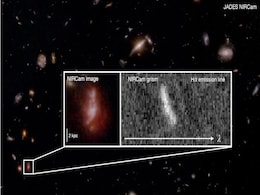

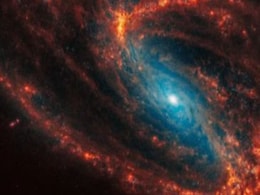
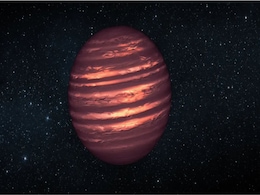
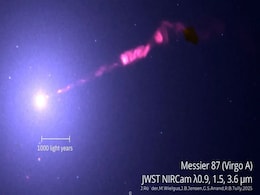



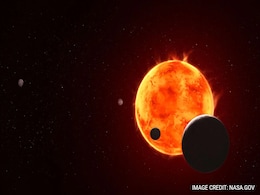
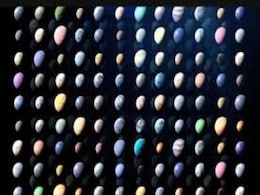
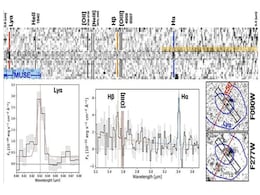
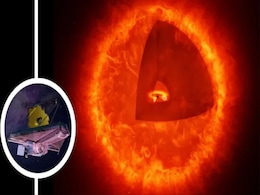
![Gadgets 360 With Technical Guruji: Did You Know? [April 6, 2024] Gadgets 360 With Technical Guruji: Did You Know? [April 6, 2024]](https://c.ndtvimg.com/2024-02/mpconh58_did-you-know_640x480_10_February_24.jpg?downsize=245:163)




